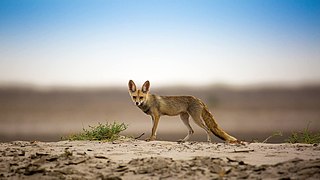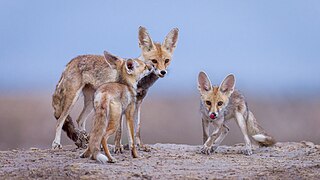
There are 38 subspecies of Canis lupus listed in the taxonomic authority Mammal Species of the World. These subspecies were named over the past 250 years, and since their naming, a number of them have gone extinct. The nominate subspecies is the Eurasian wolf.

Foxes are small-to-medium-sized omnivorous mammals belonging to several genera of the family Canidae. They have a flattened skull; upright, triangular ears; a pointed, slightly upturned snout; and a long, bushy tail ("brush").
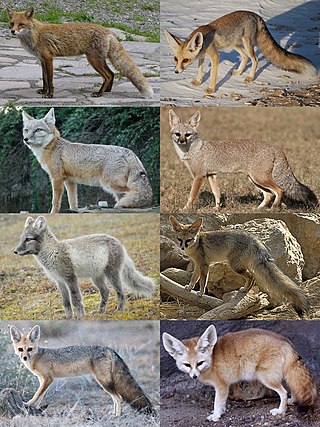
Vulpes is a genus of the sub-family Caninae. The members of this genus are colloquially referred to as true foxes, meaning they form a proper clade. The word "fox" occurs in the common names of all species of the genus, but also appears in the common names of other canid species. True foxes are distinguished from members of the genus Canis, such as domesticated dogs, wolves, jackals and coyotes, by their smaller size (5–11 kg), longer, bushier tail, and flatter skull. They have black, triangular markings between their eyes and nose, and the tip of their tail is often a different color from the rest of their pelt. The typical lifespan for this genus is between two and four years, but can reach up to a decade.

The kit fox is a fox species that inhabits arid and semi-arid regions of the southwestern United States and northern and central Mexico. These foxes are the smallest of the four species of Vulpes occurring in North America and are among the smallest of the vulpines worldwide. It has also been called a North American counterpart of the fennec fox due to its large ears.
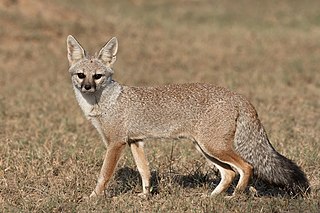
The Bengal fox, also known as the Indian fox, is a fox endemic to the Indian subcontinent from the Himalayan foothills and Terai of Nepal through southern India, and from southern and eastern Pakistan to eastern India and southeastern Bangladesh.

The Hokkaido wolf, also known as the Ezo wolf and in Russia as the Sakhalin wolf, is an extinct subspecies of gray wolf that once inhabited coastal northeast Asia. Its nearest relatives were the wolves of North America rather than Asia. It was exterminated in Hokkaido during the Meiji Restoration period, when American-style agricultural reforms incorporated the use of strychnine-laced baits to kill livestock predators. Some taxonomists believe that it survived up until 1945 on the island of Sakhalin. It was one of two subspecies that were once found in the Japanese archipelago, the other being the Japanese wolf.

The golden jackal, also called the common jackal, is a wolf-like canid that is native to Eurasia. The golden jackal's coat varies in color from a pale creamy yellow in summer to a dark tawny beige in winter. It is smaller and has shorter legs, a shorter tail, a more elongated torso, a less-prominent forehead, and a narrower and more pointed muzzle than the Arabian wolf. It is listed as Least Concern on the IUCN Red List due to its widespread distribution and high density in areas with plenty of available food and optimum shelter.
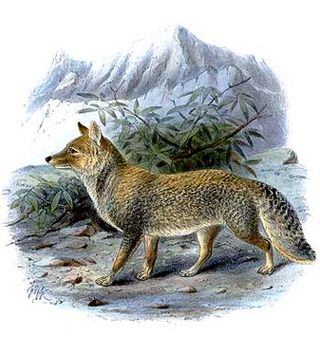
The Tibetan fox, also known as the Tibetan sand fox, is a species of true fox endemic to the high Tibetan Plateau, Ladakh plateau, Nepal, China, Sikkim, and Bhutan, up to elevations of about 5,300 m (17,400 ft). It is listed as Least Concern in the IUCN Red List, on account of its widespread range in the Tibetan Plateau's steppes and semi-deserts.

The tundra wolf, also known as the Turukhan wolf, is a subspecies of grey wolf native to Eurasia's tundra and forest-tundra zones from Finland to the Kamchatka Peninsula. It was first described in 1792 by Robert Kerr, who described it as living around the Yenisei, and of having a highly valued pelt.

The Siberian weasel or kolonok is a medium-sized weasel native to Asia, where it is widely distributed and inhabits various forest habitats and open areas. It is therefore listed as Least Concern on the IUCN Red List.

The steppe wolf, also known as the Caspian Sea wolf, is a subspecies of grey wolf native to the Caspian steppes, the steppe regions of the Caucasus, the lower Volga region, southern Kazakhstan north to the middle of the Emba, and the steppe regions of the lower European part of the former Soviet Union. It may also occur in northern Afghanistan and Iran, and possibly the steppe regions of far eastern Romania, Hungary and other areas of Eastern Europe. Studies have shown this wolf to be a host for rabies. Due to its close proximity to humans and domestic animals, the need for a reliable vaccine is high.
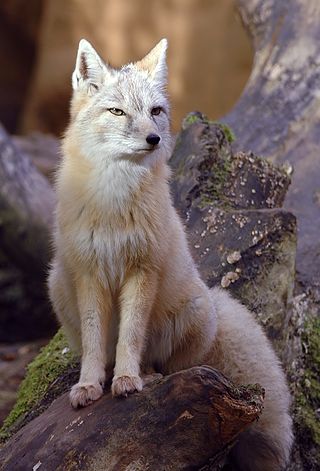
The corsac fox, also known simply as a corsac, is a medium-sized fox found in steppes, semi-deserts and deserts in Central Asia, ranging into Mongolia and northern China. Since 2004, it has been classified as least concern by IUCN, but populations fluctuate significantly, and numbers can drop tenfold within a single year. It is also known as the steppe fox. The word "corsac" is derived from the Russian name for the animal, "korsák" (корса́к), derived ultimately from Turkic "karsak".
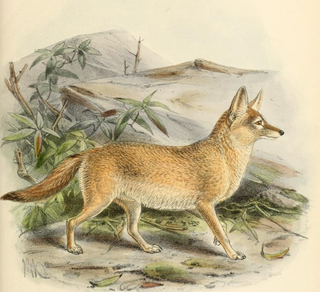
The pale fox is a species of fox found in the band of African Sahel from Senegal in the west to Sudan in the east. It is one of the least studied of all canid species, in part due to its remote habitat and its sandy coat that blends in well with the desert-like terrain. The pale fox is distinguished by its light-colored fur and oversized ears, which enable it to excel in camouflage and survival in harsh environments.

The East Siberian brown bear is a population or subspecies of brown bear which ranges from eastern Siberia, beginning at the Yenisei river, north to the Arctic Circle, as far as Trans-Baikaliya, the Stanovoy Range, the Lena River, Kolyma and generally throughout Yakutia and the Altai Mountains. The subspecies is also present in northern Mongolia, northern Xinjiang, and eastern Kazakhstan.

The red fox is the largest of the true foxes and one of the most widely distributed members of the order Carnivora, being present across the entire Northern Hemisphere including most of North America, Europe and Asia, plus parts of North Africa. It is listed as least concern on the IUCN Red List. Its range has increased alongside human expansion, having been introduced to Australia, where it is considered harmful to native small and medium-sized rodents and marsupials. Due to its impact on native species, it is included on the list of the "world's 100 worst invasive species".

The Turkmenian fox, also known as the Persian fox, is an Asiatic subspecies of red fox distinguished by its very small size and primitive cranial features. It inhabits the Middle Asian plains and approximately south of latitude of Ustyurt Plateau and the Aral Sea, as well as contiguous parts of Iran, Afghanistan and Pakistan.

The Tian Shan dhole, also known as the Siberian dhole, Western Asiatic dhole, or northern dhole is an extinct subspecies of dhole native to the Altai and Tian Shan mountain ranges, and possibly Pamir. Only 15 records of captured and killed specimens are known, and it most likely went extinct since 1946.

The Ussuri dhole, also known as the Eastern Asiatic dhole and the Chinese dhole, is the nominate subspecies of the dhole wild dog native to Asia. The Ussuri dhole subspecies is originally native to the Russian Far East and parts of China, the Korean Peninsula and Mongolia, though it is presumed regionally extinct or extirpated in most of its historical range, and it possibly exists as fragmented populations in the Russian Far East.

The Mongolian wolf is a subspecies of gray wolf which is native to Mongolia, northern and central China, Korea, and the Ussuri region of Russia.



